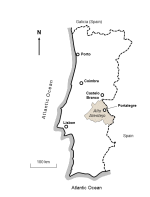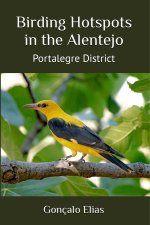Gonçalo Elias
avesdeportugal.info

The Portalegre district (also known as Alto Alentejo) is located in the northern third of the Alentejo region. It is far less visited by foreign birdwatchers than the southern part that lies closer to the Algarve.
Despite being less popular, this region holds a varied bird life, with lots of exciting birds. Some highlights include Black Stork, Night Heron, Egyptian and Cinereous Vultures, Common Crane, Great and Little Bustards, Stone Curlew, Collared Pratincole, Gull-billed Tern, Great Spotted Cuckoo, Scops Owl, Eurasian Eagle-Owl, European and Red-necked Nightjars, White-rumped Swift, Wryneck, Alpine Accentor, Great Reed Warbler, Western Orphean Warbler, Western Olivaceous Warbler, Golden Oriole, Rock Sparrow, and Hawfinch, among many others.
As for habitats, the variety is remarkable: on the one hand, the mountains, with their woods of pine, oak, and chestnut trees, attract many forest birds; on the other hand, the lowlands, where montados (‘dehesas’) and small woods alternate with farmland and scrubland, offer favourable conditions for birds of flat and open areas; and, finally, the existence of several large water bodies makes the region attractive to various species of waterbirds. These factors make the Portalegre district a great destination for bird watching.
My latest book “Birding hotspots in the Alentejo - Portalegre district” will make it easier for birders to get the best from this wonderful region. It contains a description of 24 interesting hotspots, with GPS coordinates and detailed maps. Furthermore, 12 additional sites are briefly described.
Despite being less popular, this region holds a varied bird life, with lots of exciting birds. Some highlights include Black Stork, Night Heron, Egyptian and Cinereous Vultures, Common Crane, Great and Little Bustards, Stone Curlew, Collared Pratincole, Gull-billed Tern, Great Spotted Cuckoo, Scops Owl, Eurasian Eagle-Owl, European and Red-necked Nightjars, White-rumped Swift, Wryneck, Alpine Accentor, Great Reed Warbler, Western Orphean Warbler, Western Olivaceous Warbler, Golden Oriole, Rock Sparrow, and Hawfinch, among many others.
As for habitats, the variety is remarkable: on the one hand, the mountains, with their woods of pine, oak, and chestnut trees, attract many forest birds; on the other hand, the lowlands, where montados (‘dehesas’) and small woods alternate with farmland and scrubland, offer favourable conditions for birds of flat and open areas; and, finally, the existence of several large water bodies makes the region attractive to various species of waterbirds. These factors make the Portalegre district a great destination for bird watching.
My latest book “Birding hotspots in the Alentejo - Portalegre district” will make it easier for birders to get the best from this wonderful region. It contains a description of 24 interesting hotspots, with GPS coordinates and detailed maps. Furthermore, 12 additional sites are briefly described.





